St. Helenian Coffee: Rare South Atlantic Island Gem
St. Helenian coffee is one of the rarest coffees in the world, with annual production barely exceeding 10 tons, making it a true treasure for coffee connoisseurs.

St. Helenian coffee is a rare and exotic gem in the world of specialty coffee. Grown on the remote island of Saint Helena in the South Atlantic Ocean, this coffee is known for its exceptional quality and unique flavor profile. The island's isolated location, combined with its volcanic soil and ideal climate, creates perfect conditions for cultivating high-quality Arabica beans. St. Helenian coffee is characterized by its smooth, clean taste, medium body, and bright acidity, offering a truly distinctive cup that reflects its extraordinary origin.
History
Coffee was first introduced to Saint Helena in 1733 when seeds were brought from Yemen. The island's coffee industry flourished in the 19th century but declined due to economic challenges. In recent years, there has been a revival of coffee production on Saint Helena, with a focus on quality over quantity. The island's most famous resident, Napoleon Bonaparte, was said to have enjoyed the local coffee during his exile on Saint Helena from 1815 to 1821, contributing to its historical significance and mystique.

St. Helenian
Local Coffee Customs
Economic Impact
Awards
- Cup of Excellence (2019)
Brewing Methods
- Pour-over
- French Press
- Espresso
Certifications
- Rainforest Alliance
- Organic
Common Varieties
- Green Tipped Bourbon
- Typica
- Kent
Flavor Profile
- Citrus
- Caramel
- Floral
Popular Brands & Roasters
- St Helena Coffee
- Sea Island Coffee
- Harrods St Helena Coffee
Tourism & Culture
Visitors to Saint Helena can tour the coffee plantations, particularly in the Sandy Bay area. The St Helena Coffee Shop in Jamestown offers tastings and educational experiences about the island's coffee production.
Future Outlook
With increasing global recognition and demand for unique, high-quality coffees, St. Helenian coffee is poised for growth. The island's commitment to sustainable practices and quality control suggests a bright future for this rare and sought-after origin.
Roast Recommendations
- Medium
- Medium-Light
Sustainability Practices
- Organic farming methods
- Water conservation
Traditional Preparation Methods
- French Press
- Pour-over
Typical Harvest Season
Typical Processing Methods
- Washed
- Natural
- Pulped Natural




